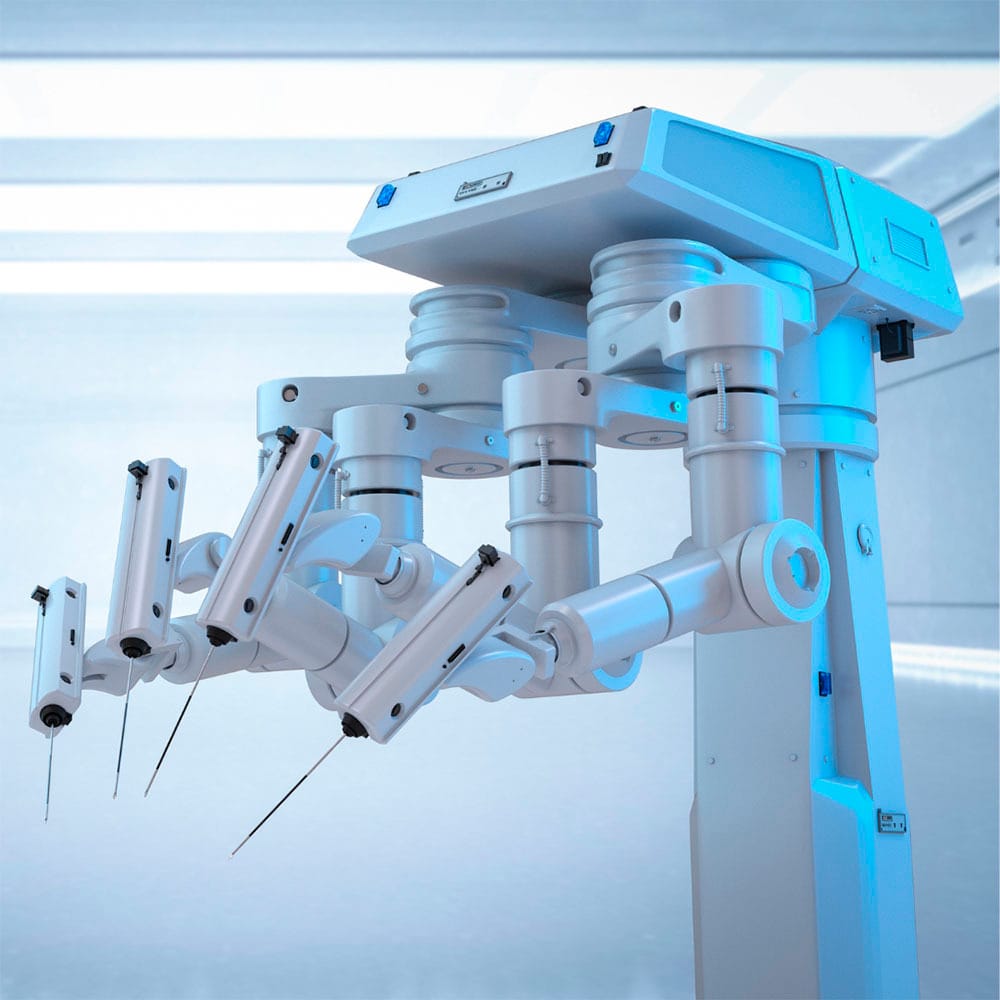What Is a Robotic Hysterectomy?
 A robotic hysterectomy also called da Vinci® hysterectomy is a minimally invasive procedure during which your doctor removes your uterus with the help of a robotic surgical system. This latest technology helps surgeons perform the surgery with precision, control and flexibility.
A robotic hysterectomy also called da Vinci® hysterectomy is a minimally invasive procedure during which your doctor removes your uterus with the help of a robotic surgical system. This latest technology helps surgeons perform the surgery with precision, control and flexibility.
A robotic system like the da Vinci Surgical System is placed near you and your surgeon operates the robot by using a controller that provides a 3D high-definition view of the surgical area. Your surgeon carefully separates your uterus from the surrounding tissues using robotic tools.
With robotic surgery, you get the benefits of both open and laparoscopic surgery, including:
- Smaller incisions
- Reduced blood loss
- Less post-operative pain
- Shorter hospital stays
- Faster recovery
- Lower risk of infection and complications
If you’re facing conditions that require a hysterectomy, find exceptional gynecological services from Dr. Felix Cohen, a leading NYC gynecologist who specializes in feminine health and robotic-assisted hysterectomy surgery. At Cohen Medical Practice (CMP) in Midtown New York, you receive the most accurate diagnoses and effective treatments for all your feminine health needs.
Am I a Candidate for a Robotic Hysterectomy?
There are several medical conditions that may cause your doctor to recommend a hysterectomy, like when you’re suffering from uterine fibroids that are causing heavy bleeding and pain. Endometriosis is a condition that also requires hysterectomy when tissue similar to the lining of your uterus grows outside of it and leads to fertility problems.
However, not everyone is suited for this type of procedure, particularly if you expect to retain your fertility. But if your symptoms are severe and have not improved with other treatments, robotic hysterectomy could be the best option.
Other medical conditions that may be best treated by da Vinci hysterectomy include:
- Chronic pelvic pain, ongoing pelvic discomfort that impacts daily life
- Gynecological cancers such as cervical, uterine or ovarian cancer
- Uterine prolapse, when the uterus shifts into or outside the vaginal canal
- Abnormal uterine bleeding, that doesn’t respond to any other treatment
- Adenomyosis, when uterine lining tissue grows into the muscle walls of the uterus
Your doctor reviews your medical history, the severity of your condition and your overall health to determine if robotic hysterectomy is the right option for you. Robotic surgery can also be a better option if you have a higher body mass index or other health concerns. Your surgeon can easily complete complex tasks with this advanced technology.
How Is the Robotic Hysterectomy Procedure Performed?
Your surgeon gives general anesthesia to ensure you’re completely asleep throughout the surgery and won’t feel any pain. The surgical area on your abdomen is then cleaned and prepared for the procedure. Your surgeon makes several small incisions in your abdomen of around one centimeter each. These tiny openings are much smaller than those used in traditional open surgery, which helps in quicker healing and less scarring.
Robotic hysterectomy steps then include:
- Inserting robotic instruments. A high-quality camera and special surgical tools are passed through the small incisions. These tools are attached to robotic arms, which are controlled by your CMP surgeon.
- Moving tools at the console. Your surgeon then moves to the control using hand and foot pedals, where he guides the robotic arms throughout the entire procedure.
- Visualizing high-definition 3D pictures. A 3D camera gives your surgeon a magnified view of your pelvic area, which helps him see your organs and tissues in detail.
- Performing necessary removals. Your surgeon then carefully cuts and detaches your uterus from surrounding tissues. Depending on your condition, your surgeon may also remove your ovaries, fallopian tubes or cervix.
- Removing instruments. The robotic instruments are then removed, and your small incisions are closed with stitches or surgical glue.
The 3D view helps your surgeon move carefully and avoid harming any nearby structures. He makes sure every step is performed with the highest level of accuracy. After removing your uterus, your CMP doctor ensures that everything looks good and there’s no excessive bleeding. Robotic hysterectomy surgery time usually takes between three and four hours to complete.
What Risks and Side Effects Can Arise from a Robotic Hysterectomy?
When you’re under general anesthesia, you may have risk of allergic reactions to the anesthesia, heart-related issues or breathing difficulties. All risks are greatly mitigated when you rely on the experienced surgical team at CMP. Make sure to follow post-surgery instructions given by Dr. Cohen, which can actively reduce your risks and contribute to a safe and successful recovery.
Post-operative instructions include:
- Getting sufficient rest
- Avoiding lifting more than 10 pounds
- No douching, sex or inserting tampons
- Taking pain medication as directed
- No driving for one week
- Standing and walking lightly every two hours to prevent blood clots
You must go for your follow-up visit one to two weeks after the surgery when Dr. Cohen ensures everything is healing perfectly and discusses the next steps for a full recovery, which includes menopause care if you haven’t undergone menopause yet. You can expect partial hysterectomy recovery within six weeks when you can get back to your normal activities. Contact Cohen Medical Practice (CMP) in Midtown NYC today to discuss your options.

